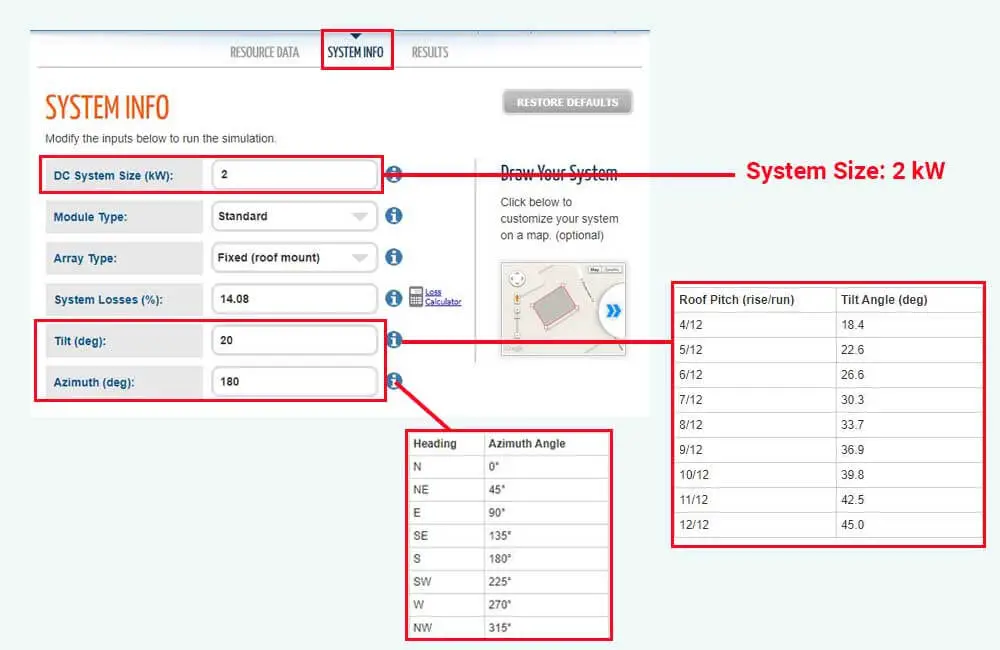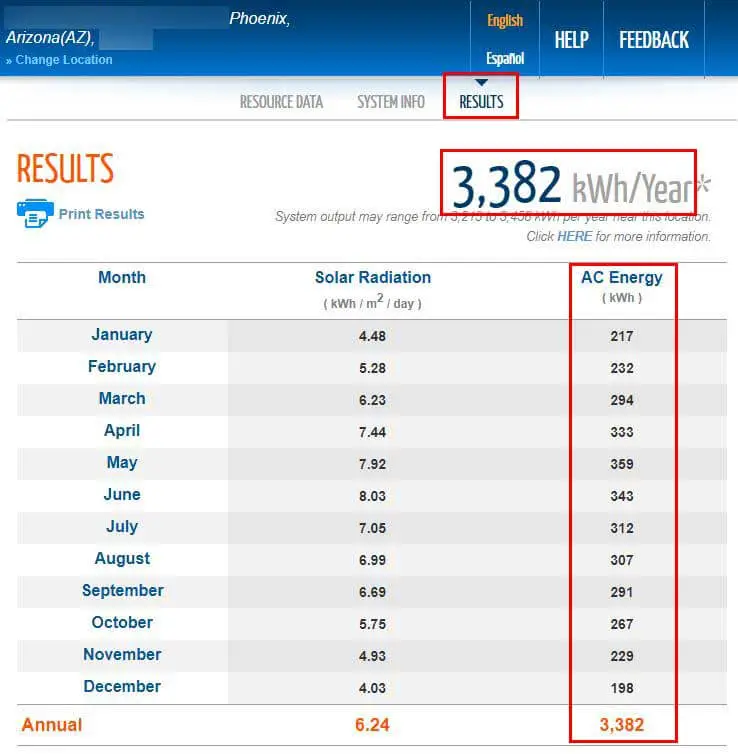In the summer, with the right weather conditions, a 2kW (2000 Watts) solar system could produce up to 2 kiloWatts (or 2000 Watts) of power, or even more in some cases.
However, what really matters at the end of the day, literally, is not the amount of power (in Watts or kiloWatts) that the system produces, but the amount of energy (in Watt-hours or kiloWatt-hours) that it generates.
So, really, rather than asking “how much power does a 2kW system produce?”, the question that should be asked is “how much energy does a 2kW solar system produce?”.
In this article, I’ll discuss the amount of energy that a 2kW is capable of producing and the variables that influence this amount of energy. Then, I’m going to put that amount of energy into perspective by discussing what you can do with it.
How much energy does a 2kw solar system produce?
The daily energy production of a solar system of any size mainly depends on how much sunlight the system receives. And the amount of sunlight that a solar system receives itself depends on many variables, such as weather conditions, location, season, and the tilt angle of the solar system and the direction it is facing.
However, as a rule of thumb, a 2kW (2000 Watt) solar system will on average generate around 8 kWh of energy per day, which amounts to about 240 kWh of energy per month, or about 3000 kWh per year.
Depending on its location, tilt angle, and the direction it’s facing, a 2kW solar system can generate as much as 15 kWh of energy in a single day in the summer or as little as 4 kWh in the winter.
To give you an idea, the following table provides the average daily energy production (kiloWatt-hours per day) of a 2kW system in the months of June and December in 11 different states:
| State | Average Daily Energy Production in June | Average Daily Energy Production in December |
| Arizona | 11.5 kWh/day | 7.8 kWh/day |
| Texas | 9.4 kWh/day | 6.3 kWh/day |
| Florida | 8.2 kWh/day | 6.5 kWh/day |
| California | 11.9 kWh/day | 5 kWh/day |
| Massachusetts | 8.6 kWh/day | 3.9 kWh/day |
| Nevada | 12.1 kWh/day | 5.5 kWh/day |
| Vermont | 8.2 kWh/day | 3.5 kWh/day |
| Utah | 11.2 kWh/day | 4.4 kWh/day |
| North Carolina | 9 kWh/day | 5.5 kWh/day |
| New Jersey | 9.2 kWh/day | 4.2 kWh/day |
| New Mexico | 11.5 kWh/day | 7.5 kWh/day |
You can get some pretty accurate predictions and estimates using the PVWatts Calculator by NREL (the National Renewable Energy Laboratory).
The tool uses the location and the size (kW rating) of the solar system, along with other variables that describe the installation, to predict the energy production of the system throughout the year.
To get these estimates, the first step is to go to the PVWatts Calculator and submit the area in which the 2kW solar system is going to be located.

Then go to the “System Info” section of the tool and submit the correct details:

As shown in the image above, in the “System Info” section of the tool, you’ll see 6 fields. I recommend you leave the Module Type, Array Type, and System Losses fields to their default values, and change the values in the following fields:
DC system size (kW):
This represents the Power rating of the solar system in kiloWatts (kW). In our case, the solar system is rated at 2 kW.
Tilt (deg):
This represents the angle at which the solar panels are going to be titled.
The tilt angle of the solar system is going to influence the amount of sunlight it receives, and therefore, it’ll influence the amount of power and energy the solar system produces. Make sure to submit the correct tilt angle of your 2kW system to get the most accurate estimates.
For example, if the solar panels are going to be installed on a flat surface, such as the roof of your RV, the tilt angle is 0 degrees.
If the solar panels are going to be installed on a tilted roof, you can click on the information “I” icon to the right of the field to see the equivalent of your roof pitch in degrees. For example, a 4/12 roof pitch is equivalent to a tilt angle of 18.4 degrees.
If you don’t know what your roof pitch is, you can use a smartphone app such as Measure for iOS or Bubble Level for Android to determine the tilt angle.
Azimuth (deg):
Azimuth represents the direction that the solar panels are facing. An Azimuth of 0 degrees means that the solar panels are facing North. An Azimuth of 180 degrees means that the solar panels are facing South.
The direction that the solar panels will be facing also influences the amount of sunlight they receive and the amount of power and energy that they produce. So make sure to submit the correct Azimuth to get accurate estimates.
In the U.S., or in any location north of the equator in general, the most optimal direction for the solar panels to face is South (180-degree Azimuth). In locations south of the equator, such as Australia, the most optimal heading is North (0-degree Azimuth)
If your solar panels are going to be roof-mounted, and since not all roofs face South or North directly, you can use a compass app such as Commander Compass Go for iOS or Azimuth Compass for Android to determine the exact direction your roof is facing.
Once you submit the size of the system (2kW), its Tilt Angle, and Azimuth, the last step is to go to the “Results” section of the PVWatts Calculator to get your estimates.
To give you an example, I’ll submit the following details to the calculator and show you the results:
- Address: an address in Phoenix, Arizona.
- DC System Size: 2kW.
- Tilt: I’ll assume the system is roof-mounted with a 5/12 roof pitch, which is equivalent to a tilt angle of 22.6 degrees.
- Azimuth: I’ll assume that the only unshaded roof section available is facing South-West, this equates to an Azimuth of 225 degrees.
In the Results tab, the calculator provided the following table:

The PVWatts Calculator has estimated that a 2kW solar system in that particular location in Phoenix, AZ, that is titled at an angle of 22.6 degrees, and that is facing South-West, would on average produce 3382 kWh of energy per year.
In the table, you can also see energy production estimates for each month, which you can divide by 30 to determine the average daily energy production for a specific month.
For example, while the 2kW solar system would only produce about 198 kWh of energy in December, which translates to 6.6 kWh of energy per day, the 2kW system would produce around 359 kWh of energy in May, which is equivalent to about 12 kWh/day.
Once you’ve estimated the amount of energy that a 2kW system is going to produce, the next section will help you put this amount of energy into perspective.
Is 2kW enough to power a house?
The short answer is no, a 2kW solar system would not be able to offset the energy consumption of the average American household.
According to the EIA (U.S. Energy Information Administration), the average annual energy consumption of a U.S. residential utility customer is around 10600 kWh. A 2kWh solar system, on the other hand, would not exceed an annual energy production of 3500 kWh.
In other words, a 2kW solar system would only be able to offset 25 to 30% of the energy consumption of the average American household. However, if your daily energy consumption does not exceed 8 kWh/day, a 2kW solar system should be enough.
For example, let’s say you’re trying to run a 20 Cu. ft. refrigerator, a 5000 BTU air conditioner, a 32″ LED TV, 2 laptops, and 3 LED light bulbs.
The amount of energy the refrigerator and the air conditioner use will depend on the outdoor temperature. But on average, a 20 cubic feet fridge would consume about 1.8 kWh per day; and assuming it’s left on for about 8 hours a day, a 5000 BTU window air conditioner would consume about 2.5 kWh of energy per day.
A 32″ LED TV uses about 40Wh of energy per hour (0.04 kWh/hour). So assuming the TV is left on for 5 hours a day, it would consume about 200Wh of energy per day or 0.2 kWh/day.
A laptop uses around 60 Wh of energy per hour of use (0.06 kWh/hour). So assuming the 2 laptops are also used for about 5 hours a day, both laptops would consume around 600 Wh of energy per day or 0.6 kWh/day.
An LED light only uses about 10 Wh of energy per hour (0.01 kWh/hour). Assuming the 3 LED light bulbs are left on for 6 hours a day, they would use about 30 Wh of energy per hour, which translates to about 180 Wh of energy per day, or 0.18 kWh/day.
Related:
How much solar power to run a refrigerator?
How much electricity does a window AC use?
How much electricity does a TV use?
So, this is the daily energy consumption of each of our appliances:
- Refrigerator: 1.8 kWh/day
- Air conditioner: 2.5 kWh/day
- TV: 0.2 kWh/day
- 2 Laptops: 0.6 kWh/day
- 3 LED light bulbs: 0.18 kWh/day
If we add all of these together we can determine our daily energy consumption:
Daily Energy Consumption (kWh/day) = 1.8 + 2.5 + 0.2 + 0.6 + 0.18
Daily Energy Consumption (kWh/day) = 5.28 kWh/day
With a daily energy consumption of 5.28 kWh/day, a 2kW solar system would definitely be enough.
If you’re trying to offset 100% of the energy consumption in your house, you might find one of the following pages useful:
How many solar panels do I need for 1000 kWh per month?
How many solar panels do I need for 1500 kWh per month?
How many solar panels do I need for 2000 kWh per month?
How many panels will you need for a 2kW (2000 Watt) solar system?
Typically, you would need between 5 and 10 solar panels for a 2kW solar system. The number of solar panels required for a 2000 Watt system would depend on the power rating of the solar panels you’re planning on using.
For example, if you’re planning on using solar panels that are rated at 400 Watts each, you would need 5 of these panels to form a 2kW system (5 x 0.4 kW). If the solar panels are rated at 200 Watts each, you would need 10 panels (10 x 0.2 kW).
How many batteries for 2kw solar system?
As mentioned above, on average, a 2kW (2000 Watt) solar system produces around 8 kWh (kiloWatt-hours) or 8000 Wh (Watt-hours) of energy each day. To store and access this amount of energy, you would need – at least – 8 batteries rated at 12V-100Ah, 4 batteries rated at 24V-100Ah, or 2 batteries rated at 48V-100Ah.
However, the battery bank that you need for your solar system should not be sized based on the potential daily energy production of your solar panels but based on your daily energy consumption.
Other factors such as Depth Of Discharge (DOD) and Days of Autonomy should also be taken into consideration when calculating battery capacity.
Read more on this subject here: How to calculate battery capacity for a solar system?
Related Topics:
How much does a 12kW solar system produce?
How much does a 10kW solar system produce?
How much does a 7kW solar system produce?

